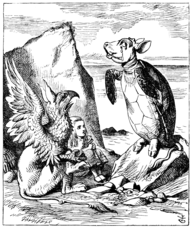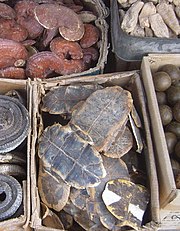Turtle
| Turtles Temporal range:
| |
|---|---|

| |
| Turtles from different families; clockwise from top-left: Red-bellied short-necked turtle, Indian flapshell turtle, Hawksbill sea turtle, and Galápagos tortoise | |
| Scientific classification | |
| Domain: | Eukaryota |
| Kingdom: | Animalia |
| Phylum: | Chordata |
| Class: | Reptilia |
| Clade: | Pantestudines |
| Clade: | Testudinata |
| Clade: | Perichelydia |
| Order: | Testudines Batsch, 1788[1]
|
| Subgroups | |
| Diversity | |
| 14 living families | |
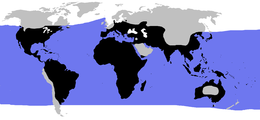
| |
| Blue: sea turtles, black: land turtles | |
| Synonyms[2] | |
| |
Turtles, or testudines, are
Turtle shells are made mostly of
Turtles have appeared in myths and folktales around the world. Some terrestrial and freshwater species are widely kept as pets. Turtles have been hunted for their meat, for use in traditional medicine, and for their shells. Sea turtles are often killed accidentally as bycatch in fishing nets. Turtle habitats around the world are being destroyed. As a result of these pressures, many species are extinct or threatened with extinction.
Naming and etymology
The word turtle is borrowed from the French word tortue or tortre 'turtle, tortoise'.[3] It is a common name and may be used without knowledge of taxonomic distinctions. In North America, it may denote the order as a whole. In Britain, the name is used for sea turtles as opposed to freshwater terrapins and land-dwelling tortoises. In Australia, which lacks true tortoises (family Testudinidae), non-marine turtles were traditionally called tortoises, but more recently turtle has been used for the entire group.[4]
The name of the order, Testudines (/tɛˈstjuːdɪniːz/ teh-STEW-din-eez), is based on the Latin word testudo 'tortoise';[5] and was coined by German naturalist August Batsch in 1788.[1] The order has also been historically known as Chelonii (Latreille 1800) and Chelonia (Ross and Macartney 1802),[2] which are based on the Ancient Greek word χελώνη (chelone) 'tortoise'.[6][7] Testudines is the official order name due to the principle of priority.[2] The term chelonian is used as a formal name for members of the group.[1][8]
Anatomy and physiology
Size
The largest
Shell
The shell of a turtle is unique among vertebrates and serves to protect the animal and provide shelter from the elements.[13][14][15] It is primarily made of 50–60 bones and consists of two parts: the domed, dorsal (back) carapace and the flatter, ventral (belly) plastron. They are connected by lateral (side) extensions of the plastron.[13][16]
The carapace is fused with the vertebrae and ribs while the plastron is formed from bones of the shoulder girdle, sternum, and gastralia (abdominal ribs).[13] During development, the ribs grow sideways into a carapacial ridge, unique to turtles, entering the dermis (inner skin) of the back to support the carapace. The development is signaled locally by proteins known as fibroblast growth factors that include FGF10.[17] The shoulder girdle in turtles is made up of two bones, the scapula and the coracoid.[18] Both the shoulder and pelvic girdles of turtles are located within the shell and hence are effectively within the rib cage. The trunk ribs grow over the shoulder girdle during development.[19]
The shell is covered in
The shapes of turtle shells vary with the adaptations of the individual species, and sometimes with sex. Land-dwelling turtles are more dome-shaped, which appears to make them more resistant to being crushed by large animals. Aquatic turtles have flatter, smoother shells that allow them to cut through the water. Sea turtles in particular have streamlined shells that reduce drag and increase stability in the open ocean. Some turtle species have pointy or spiked shells that provide extra protection from predators and camouflage against the leafy ground. The lumps of a tortoise shell can tilt its body when it gets flipped over, allowing it to flip back. In male tortoises, the tip of the plastron is thickened and used for butting and ramming during combat.[22]
Shells vary in flexibility. Some species, such as
Head and neck

The turtle's skull is unique among living
Turtles that are carnivorous or
The necks of turtles are highly flexible, possibly to compensate for their rigid shells. Some species, like sea turtles, have short necks while others, such as
Limbs and locomotion
Due to their heavy shells, turtles are slow-moving on land. A
Sea turtles and the pig-nosed turtle are the most specialized for swimming. Their front limbs have evolved into flippers while the shorter hind limbs are shaped more like rudders. The front limbs provide most of the thrust for swimming, while the hind limbs serve as stabilizers.[13][36] Sea turtles such as the green sea turtle rotate the front limb flippers like a bird's wings to generate a propulsive force on both the upstroke and on the downstroke. This is in contrast to similar-sized freshwater turtles (measurements having been made on young animals in each case) such as the Caspian turtle, which uses the front limbs like the oars of a rowing boat, creating substantial negative thrust on the recovery stroke in each cycle. In addition, the streamlining of the marine turtles reduces drag. As a result, marine turtles produce a propulsive force twice as large, and swim six times as fast, as freshwater turtles. The swimming efficiency of young marine turtles is similar to that of fast-swimming fish of open water, like mackerel.[35]
Compared to other reptiles, turtles tend to have reduced tails, but these vary in both length and thickness among species and between sexes.
Senses

Turtles make use of vision to find food and mates, avoid predators, and orient themselves. The retina's light-sensitive cells include both rods for vision in low light, and cones with three different photopigments for bright light, where they have full-color vision. There is possibly a fourth type of cone that detects ultraviolet, as hatchling sea turtles respond experimentally to ultraviolet light, but it is unknown if they can distinguish this from longer wavelengths. A freshwater turtle, the red-eared slider, has an exceptional seven types of cone cell.[38][39][40]
Sea turtles orient themselves on land by night, using visual features detected in dim light. They can use their eyes in clear surface water, muddy coasts, the darkness of the deep ocean, and also above water. Unlike in terrestrial turtles, the
Turtles have no ear openings; the
Turtles have olfactory (smell) and vomeronasal receptors along the nasal cavity, the latter of which are used to detect chemical signals.[43] Experiments on green sea turtles showed they could learn to respond to a selection of different odorant chemicals such as triethylamine and cinnamaldehyde, which were detected by olfaction in the nose. Such signals could be used in navigation.[44]
Breathing
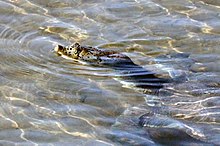
The rigid shell of turtles is not capable of expanding and making room for the lungs, as in other amniotes, so they have had to evolve special adaptations for respiration.[45][46][47] The lungs of turtles are attached directly to the carapace above while below, connective tissue attaches them to the organs.[48] They have multiple lateral (side) and medial (middle) chambers (the numbers of which vary between species) and one terminal (end) chamber.[49]
The lungs are ventilated using specific groups of abdominal muscles attached to the organs that pull and push on them.
Although many turtles spend large amounts of their lives underwater, all turtles breathe air and must surface at regular intervals to refill their lungs. Depending on the species, immersion periods vary between a minute and an hour.[51] Some species can respire through the cloaca, which contains large sacs that are lined with many finger-like projections that take up dissolved oxygen from the water.[52]
Circulation
Turtles share the linked
The heart has two atria but only one ventricle. The ventricle is subdivided into three chambers. A muscular ridge enables a complex pattern of blood flow so that the blood can be directed either to the lungs via the pulmonary artery, or to the body via the aorta. The ability to separate the two outflows varies between species. The leatherback has a powerful muscular ridge enabling almost complete separation of the outflows, supporting its actively swimming lifestyle. The ridge is less well developed in freshwater turtles like the sliders (Trachemys).[53]
Turtles are capable of enduring periods of anaerobic respiration longer than many other vertebrates. This process breaks down sugars incompletely to
Osmoregulation
In sea turtles, the bladder is one unit and in most freshwater turtles, it is double-lobed.
Thermoregulation

Turtles, like other reptiles, have a limited ability to
Adult sea turtles, too, have large enough bodies that they can to some extent control their temperature. The largest turtle, the leatherback, can swim in the waters off
Behavior
Diet and feeding
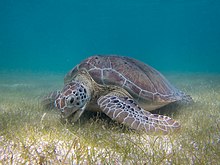
Most turtle species are opportunistic omnivores; land-dwelling species are more herbivorous and aquatic ones more carnivorous.[26] Generally lacking speed and agility, most turtles feed either on plant material or on animals with limited movements like mollusks, worms, and insect larvae.[13] Some species, such as the African helmeted turtle and snapping turtles, eat fish, amphibians, reptiles (including other turtles), birds, and mammals. They may take them by ambush but also scavenge.[60] The alligator snapping turtle has a worm-like appendage on its tongue that it uses to lure fish into its mouth. Tortoises are the most herbivorous group, consuming grasses, leaves, and fruits.[61] Many turtle species, including tortoises, supplement their diet with eggshells, animal bones, hair, and droppings for extra nutrients.[62]
Turtles generally eat their food in a straightforward way, though some species have special feeding techniques.
The diet of an individual within a species may change with age, sex, and season, and may also differ between populations. In many species, juveniles are generally carnivorous but become more herbivorous as adults.
Communication and intelligence
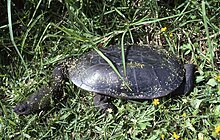
While popularly thought of as mute, turtles make various sounds to communicate.[69][70] One study which recorded 53 species found that all of them vocalized.[71] Tortoises may bellow when courting and mating.[70][31] Various species of both freshwater and sea turtles emit short, low-frequency calls from the time they are in the egg to when they are adults. These vocalizations may serve to create group cohesion when migrating.[70] The oblong turtle has a particularly large vocal range; producing sounds described as clacks, clicks, squawks, hoots, various kinds of chirps, wails, hooos, grunts, growls, blow bursts, howls, and drum rolls.[68]
Play behavior has been documented in some turtle species.[72] In the laboratory, Florida red-bellied cooters can learn novel tasks and have demonstrated a long-term memory of at least 7.5 months.[73] Similarly, giant tortoises can learn and remember tasks, and master lessons much faster when trained in groups.[74] Tortoises appear to be able to retain operant conditioning nine years after their initial training.[75] Studies have shown that turtles can navigate the environment using landmarks and a map-like system resulting in accurate direct routes towards a goal.[76] Navigation in turtles have been correlated to high cognition function in the medial cortex region of the brain.[76][77]

Defense
When sensing danger, a turtle may flee, freeze or withdraw into its shell. Freshwater turtles flee into the water, though the Sonora mud turtle may take refuge on land as the shallow temporary ponds they inhabit make them vulnerable.[78] When startled, a softshell turtle may dive underwater and bury itself under the sea floor.[79] If a predator persists, the turtle may bite or discharge from its cloaca. Several species produce foul-smelling chemicals from musk glands. Other tactics include threat displays and Bell's hinge-back tortoise can play dead. When attacked, big-headed turtle hatchlings squeal, possibly startling the predator.[80]
Migration

Turtles are the only reptiles that migrate long distances, more specifically the marine species that can travel up to thousands of kilometers. Some non-marine turtles, such as the species of
How sea turtles navigate to their breeding beaches remains unknown. One possibility is imprinting as in salmon, where the young learn the chemical signature, effectively the scent, of their home waters before leaving, and remember that when the time comes for them to return as adults. Another possible cue is the orientation of the Earth's magnetic field at the natal beach. There is experimental evidence that turtles have an effective magnetic sense, and that they use this in navigation. Proof that homing occurs is derived from genetic analysis of populations of loggerheads, hawksbills, leatherbacks, and olive ridleys by nesting place. For each of these species, the populations in different places have their own mitochondrial DNA genetic signatures that persist over the years. This shows that the populations are distinct and that homing must be occurring reliably.[82]
Reproduction and life cycle

Turtles have a wide variety of mating behaviors but do not form pair-bonds or social groups.[83] In green sea turtles, females generally outnumber males.[84] In terrestrial species, males are often larger than females and fighting between males establishes a dominance hierarchy for access to mates. For most semi-aquatic and bottom-walking aquatic species, combat occurs less often. Males of these species instead may use their size advantage to mate forcibly. In fully aquatic species, males are often smaller than females and rely on courtship displays to gain mating access to females.[85]
Courtship and mounting
Courtship varies between species, and with habitat. It is often complex in aquatic species, both marine and freshwater, but simpler in the semi-aquatic mud turtles and snapping turtles. A male tortoise bobs his head, then subdues the female by biting and butting her before mounting.[13] The male scorpion mud turtle approaches the female from the rear, and often resorts to aggressive methods such as biting the female's tail or hind limbs, followed by a mounting.[86]
Female choice is important in some species, and female green sea turtles are not always receptive. As such, they have evolved behaviors to avoid the male's attempts at copulation, such as swimming away, confronting the male followed by biting or taking up a refusal position with her body vertical, her limbs widely outspread, and her plastron facing the male. If the water is too shallow for the refusal position, the females resort to beaching themselves, as the males do not follow them ashore.[84]
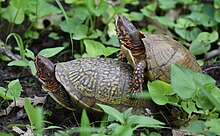
All turtles fertilize internally; mounting and copulation can be difficult. In many species, males have a concave plastron that interlocks with the female's carapace. In species like the Russian tortoise, the male has a lighter shell and longer legs. The high, rounded shape of box turtles are particular obstacles for mounting. The male eastern box turtle leans backward and hooks onto the back of the female's plastron.[87] Aquatic turtles mount in water,[88][89] and female sea turtles support the mounting male while swimming and diving.[90] During copulation, the male turtle aligns his tail with the female's so he can insert his penis into her cloaca.[91] Some female turtles can store sperm from multiple males and their egg clutches can have multiple sires.[92][83]
Eggs and hatchlings

Turtles, including sea turtles, lay their eggs on land, although some lay eggs near water that rises and falls in level, submerging the eggs. While most species build nests and lay eggs where they forage, some travel miles. The common snapping turtle walks 5 km (3 mi) on land, while sea turtles travel even further; the leatherback swims some 12,000 km (7,500 mi) to its nesting beaches.[13][89] Most turtles create a nest for their eggs. Females usually dig a flask-like chamber in the substrate. Other species lay their eggs in vegetation or crevices.[93] Females choose nesting locations based on environmental factors such as temperature and humidity, which are important for developing embryos.[89] Depending on the species, the number of eggs laid varies from one to over 100. Larger females can lay eggs that are greater in number or bigger in size. Compared to freshwater turtles, tortoises deposit fewer but larger eggs. Females can lay multiple clutches throughout a season, particularly in species that experience unpredictable monsoons.[94]
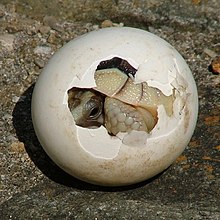
Most mother turtles do no more in the way of parental care than covering their eggs and immediately leaving, though some species guard their nests for days or weeks.
Hatching young turtles break out of the shell using an egg tooth, a sharp projection that exists temporarily on their upper beak.[13][99] Hatchlings dig themselves out of the nest and find safety in vegetation or water. Some species stay in the nest for longer, be it for overwintering or to wait for the rain to loosen the soil for them to dig out.[13] Young turtles are highly vulnerable to predators, both in the egg and as hatchlings. Mortality is high during this period but significantly decreases when they reach adulthood. Most species grow quickly during their early years and slow down when they are mature.[100]
Lifespan
Turtles can live long lives. The oldest living turtle and land animal is said to be a Seychelles giant tortoise named Jonathan, who turned 187 in 2019.[101] A Galápagos tortoise named Harriet was collected by Charles Darwin in 1835; it died in 2006, having lived for at least 176 years. Most wild turtles do not reach that age. Turtles keep growing new scutes under the previous scutes every year, allowing researchers to estimate how long they have lived.[102] They also age slowly.[103] The survival rate for adult turtles can reach 99% per year.[13]
Systematics and evolution
Fossil history

Zoologists have sought to explain the evolutionary origin of the turtles, and in particular of their unique shells. In 1914,
More recent discoveries have painted a different scenario for the evolution of the turtle's shell. The stem-turtles Eunotosaurus of the Middle Permian, Pappochelys of the Middle Triassic, and Eorhynchochelys of the Late Triassic lacked carapaces and plastrons but had shortened torsos, expanded ribs, and lengthened dorsal vertebrae. Also in the Late Triassic, Odontochelys had a partial shell consisting of a complete bony plastron and an incomplete carapace. The development of a shell reached completion with the Late Triassic Proganochelys, with its fully developed carapace and plastron.[19][105] Adaptations that led to the evolution of the shell may have originally been for digging and a fossorial lifestyle.[105]
The oldest known members of the Pleurodira lineage are the Platychelyidae, from the Late Jurassic.[106] The oldest known unambiguous cryptodire is Sinaspideretes, a close relative of softshell turtles, from the Late Jurassic of China.[107] During the Late Cretaceous and Cenozoic, members of the pleurodire families Bothremydidae and Podocnemididae became widely distributed in the Northern Hemisphere due to their coastal habits.[108][109] The oldest known soft-shelled turtles and sea turtles appeared during the Early Cretaceous.[110][111] Tortoises originated in Asia during the Eocene.[112] A late surviving group of stem-turtles, the Meiolaniidae, survived in Australasia into the Pleistocene and Holocene.[113]
External relationships
The turtles' exact ancestry has been disputed. It was believed they were the only surviving branch of the ancient
Some early morphological
Using the draft (unfinished) genome sequences of the green sea turtle and the Chinese softshell turtle, Zhuo Wang and colleagues (2013) concluded that turtles are likely a sister group of crocodilians and birds.[123] The external phylogeny of the turtles is shown in the cladogram below.[122]
Diapsida
|
| ||||||||||||||||||
Internal relationships
Modern turtles and their extinct relatives with a complete shell are classified within the clade
The cladogram, from Nicholas Crawford and colleagues 2015, shows the internal phylogeny of the Testudines down to the level of families.[127][128] The analysis by Thompson and colleagues in 2021 supports the same structure down to the family level.[126]
| Testudines |
| ||||||||||||||||||||||||||||||||||||||||||||||||||||||||||||||||||||||||
Differences between the two suborders
Turtles are divided into two living suborders: Cryptodira and Pleurodira.[129] The two groups differ in the way the neck is retracted for protection. Pleurodirans retract their neck to the side and in front of the shoulder girdles, whereas cryptodirans retract their neck backward into their shell. These motions are enabled by the morphology and arrangement of neck vertebrae.[130][131] Sea turtles (which belong to Cryptodira) have mostly lost the ability to retract their heads.[132]
The adductor muscles in the lower jaw create a pulley-like system in both subgroups. However, the bones that the muscles articulate with differ. In Pleurodira, the pulley is formed with the pterygoid bones of the palate, but in Cryptodira the pulley is formed with the otic capsule. Both systems help to vertically redirect the adductor muscles and maintain a powerful bite.[133]
A further difference between the suborders is the attachment of the pelvis. In Cryptodira, the pelvis is free, linked to the shell only by ligaments. In Pleurodira, the pelvis is sutured, joined with bony connections, to the carapace and to the plastron, creating a pair of large columns of bone at the back end of the turtle, linking the two parts of the shell.[134]
Distribution and habitat
Turtles are widely distributed across the world's continents, oceans, and islands with terrestrial, fully aquatic, and semi-aquatic species. Sea turtles are mainly tropical and subtropical, but leatherbacks can be found in colder areas of the Atlantic and Pacific.[135] Living Pleurodira all live in freshwater and are found only in the Southern Hemisphere.[136] The Cryptodira include terrestrial, freshwater, and marine species, and these range more widely.[135] The world regions richest in non-marine turtle species are the Amazon basin, the Gulf of Mexico drainages of the United States, and parts of South and Southeast Asia.[137]
For turtles in colder climates, their distribution is limited by constraints on reproduction, which is reduced by long hibernations. North American species barely range above the southern Canadian border.[138] Some turtles are found at high altitudes, for example, the species Terrapene ornata occurs up to 2,000 m (6,600 ft) in New Mexico.[139] Conversely, the leatherback sea turtle can dive over 1,200 m (3,900 ft).[140] Species of the genus Gopherus can tolerate both below freezing and over 40 °C (104 °F) in body temperature, though they are most active at 26–34 °C (79–93 °F).[141]
Conservation

Among vertebrate orders, turtles are second only to
Turtle hatcheries can be set up when protection against flooding, erosion, predation, or heavy poaching is required.[151][152][153] Chinese markets have sought to satisfy an increasing demand for turtle meat with farmed turtles. In 2007 it was estimated that over a thousand turtle farms operated in China.[154] All the same, wild turtles continue to be caught and sent to market in large numbers, resulting in what conservationists have called "the Asian turtle crisis".[155][149] In the words of the biologist George Amato, the hunting of turtles "vacuumed up entire species from areas in Southeast Asia", even as biologists still did not know how many species lived in the region.[156] In 2000, all the Asian box turtles were placed on the CITES list of endangered species.[149]
Harvesting wild turtles is legal in some American states,[157] and there has been a growing demand for American turtles in China.[158][159] The Florida Fish and Wildlife Conservation Commission estimated in 2008 that around 3,000 pounds of softshell turtles were exported weekly via Tampa International Airport.[159] However, the great majority of turtles exported from the US between 2002 and 2005 were farmed.[158]
Large numbers of sea turtles are accidentally killed in
Native turtle populations can also be threatened by invasive ones. The central North American red-eared slider turtle has been listed among the "world's worst invasive species", pet turtle having been released globally. They appear to compete with native turtle species in eastern and western North America, Europe, and Japan.[161][162]
Human uses
On space flights
Two tortoises were on the Soviet Union's September 1968 Zond 5 circumlunar flight, making them the first earthly living things to travel to the vicinity of the Moon. Turtles were also on the Zond 6 (1968) and the Zond 7 (1969) circumlunar flights.[163][164]
In culture
-
World resting on four elephants on the back of the World Turtle. Western depiction of "The Hindu Earth", 1877
-
, 1698
-
Poster for 1898 production of The Turtle at the Manhattan Theatre, Broadway
-
Terrapin shell leg rattles worn by lead Cherokee woman dancer, 20th century
Turtles have featured in human cultures across the world since ancient times. They are generally viewed positively despite not being "cuddly" or flashy; their association with the ancient times and old age have contributed to their endearing image.[165]
In
A turtle was the symbol of the Ancient Mesopotamian god
In Aesop's Fables, "The Tortoise and the Hare" tells how an unequal race may be won by the slower partner.[176][177] Lewis Carroll's 1865 Alice's Adventures in Wonderland features a Mock Turtle, named for a soup meant to imitate the expensive soup made from real turtle meat.[178][179][180] In 1896, the French playwright Léon Gandillot wrote a comedy in three acts named La Tortue that was "a Parisian sensation"[181] in its run in France, and came to the Manhattan Theatre, Broadway, New York, in 1898 as The Turtle.[182] A "cosmic turtle" and the island motif reappear in Gary Snyder's 1974 novel Turtle Island, and again in Terry Pratchett's Discworld series as Great A'Tuin, starting with the 1983 novel The Colour of Magic. It is supposedly of the species Chelys galactica, the galactic turtle, complete with four elephants on its back to support Discworld.[183] A giant fire-breathing turtle called Gamera is the star of a series of Japanese monster movies in the kaiju genre and has had twelve films from 1965 to 2006.[184] Turtles have been featured in comic books and animations such as the 1984 Teenage Mutant Ninja Turtles.[185][186]
As pets
Some turtles, particularly small terrestrial and freshwater species, are kept as pets.[187][188] The demand for pet turtles increased in the 1950s, with the US being the main supplier, particularly of farm-bred red-eared sliders. The popularity for exotic pets has led to an increase in illegal wildlife trafficking. Around 21% of the value of live animal trade is in reptiles, and turtles are among the more popularly traded species.[189] Poor husbandry of tortoises can cause chronic rhinitis (nasal swelling), overgrown beaks, hyperparathyroidism (which softens their skeleton), constipation, various reproductive problems, and injuries from dogs.[187] In the early 20th century, people in the United States have organized and gambled on turtle races.[190]
As food and other uses
The flesh of captured wild turtles continues to be eaten in Asian cultures,
-
Catching turtles in Australia, 1875
-
Turtles on sale as food in Canada, 2007
-
Turtle plastrons for traditional Chinese medicine
-
A tortoiseshell comb; the material was expensive and decorative, and widely used for small items.[199]
-
A pet red-eared slider basking on a floating platform under a sun lamp
-
A notice in Bluefields, Nicaragua in 2023 indicating that the capturing and consuming of turtles is prohibited
See also
References
Citations
- ^ OCLC 1124067380. Archived (PDF) from the original on February 25, 2021. Retrieved January 20, 2018.)
{{cite book}}:|journal=ignored (help - ^ a b c Dubois, Alan; Bour, Roger (2010). "The Distinction Between Family-Series and Class-Series Nominain Zoological Nomenclature, With Emphasis on the Nomina Created by Batsch (1788, 1789) and on the Higher Nomenclature of Turtles" (PDF). Bonn Zoological Bulletin. 57 (2): 149–171. Archived (PDF) from the original on October 9, 2022.
- ^ Harper, Douglas. "turtle". Online Etymology Dictionary. Retrieved October 28, 2021.
- ^ Orenstein 2012, p. 9.
- Perseus Project.
- Perseus Project
- ^ "Chelonia". Merriam-Webster. Retrieved August 29, 2021.
- ^ Franklin 2011, p. 14.
- PMID 26391496.
- ^ "The Archelon". Black Hills Institute of Geological Research. Archived from the original on March 12, 2016. Retrieved December 23, 2018.
- ISBN 978-0-8018-8496-2.
- ISBN 978-0-12-817554-5.
- ^ ISBN 978-1-55297-613-5.
- ^ Orenstein 2012, p. 22.
- ^ Hutchinson, J. Howard (1996). "Introduction to Testudines: The Turtles". University of California Museum of Paleontology. Archived from the original on June 29, 2016. Retrieved June 4, 2003.
- ^ a b c Orenstein 2012, p. 16.
- ^ S2CID 2484583.
- from the original on May 16, 2021. Retrieved May 16, 2021.
- ^ ISSN 0031-0239.
- ^ Orenstein 2012, pp. 16–17.
- OCLC 144570900.
- ^ Orenstein 2012, pp. 22–26.
- ^ Orenstein 2012, pp. 22–23, 26–27.
- ^ a b Franklin 2011, p. 18.
- ^ a b Orenstein 2012, p. 33.
- ^ a b c d Franklin 2011, p. 28.
- S2CID 54067445.
- ^ Orenstein 2012, pp. 33–34.
- ^ Orenstein 2012, p. 34.
- PMC 4715671.
- ^ a b c Orenstein 2012, p. 36.
- S2CID 225069598.
- ISBN 978-0-12-815160-0.
- ^ Orenstein 2012, p. 38.
- ^ S2CID 84615412.
- ^ Orenstein 2012, pp. 38–40.
- ^ Orenstein 2012, p. 40.
- ^ OCLC 828509848.
- ISSN 0072-9906.
- ISBN 978-0-12-378520-6.
- PMID 26611091.
- S2CID 459652.
- ^ Orenstein 2012, pp. 35–36.
- from the original on June 6, 2021. Retrieved June 6, 2021.
- ^ from the original on July 24, 2021. Retrieved September 25, 2019.
- ^ PMID 25376734.
- S2CID 5194890.
- ^ Orenstein 2012, p. 41.
- PMID 20044019.
- S2CID 28044326.
- from the original on August 9, 2020. Retrieved June 11, 2020.
- S2CID 85279910.
- ^ OCLC 144570900.
- PMID 12231634.
- OCLC 144570900.
- ^ Wyneken, Jeanette; Witherington, Dawn (February 2015). "Urogenital System" (PDF). Anatomy of Sea Turtles. 1: 153–165. Archived (PDF) from the original on June 8, 2019. Retrieved May 18, 2021.
- ISBN 978-3-662-05014-9. Archivedfrom the original on May 31, 2021. Retrieved May 18, 2021.
- ^ Franklin 2011, p. 31.
- ^ OCLC 1022979490.
- ^ Orenstein 2012, p. 231.
- ^ Franklin 2011, pp. 29–30.
- ^ Orenstein 2012, p. 237.
- ^ Orenstein 2012, p. 235.
- S2CID 32906130.
- ^ Franklin 2011, p. 30.
- ^ Orenstein 2012, p. 239.
- ^ Orenstein 2012, p. 229.
- ^ PMID 19603900.
- ^ Pryke 2021, p. 39.
- ^ (PDF) from the original on September 2, 2017. Retrieved September 1, 2017.
- S2CID 253111242.
- .
- S2CID 34130920.
- S2CID 208613023.
- S2CID 207962281.
- ^ S2CID 23055468.
- S2CID 13763864.
- ^ Orenstein 2012, pp. 252–253.
- ^ Franklin 2011, p. 40.
- ^ Orenstein 2012, pp. 252–253, 301.
- from the original on July 24, 2021. Retrieved June 6, 2021.
- ^ OCLC 828509848.
- ^ PMID 11396580.
- ^ .
- S2CID 2456783.
- ISBN 978-0-9653540-9-7. Archived(PDF) from the original on February 4, 2019. Retrieved August 20, 2019.
- ^ Orenstein 2012, pp. 270–271.
- ^ Orenstein 2012, p. 270.
- ^ a b c Franklin 2011, p. 33.
- ISBN 978-0-89658-315-3.
- ^ Franklin 2011, pp. 20–22.
- ^ Orenstein 2012, p. 260.
- ^ Orenstein 2012, p. 277.
- ^ Orenstein 2012, pp. 273, 276.
- ^ Franklin 2011, p. 37.
- ^ Orenstein 2012, p. 274.
- PMID 31378606.
- ^ Orenstein 2012, p. 286.
- ^ Orenstein 2012, p. 294.
- ^ Orenstein 2012, pp. 301–302.
- ^ Millward, Adam (February 27, 2019). "Introducing Jonathan, the World's Oldest Animal on Land at 187 Years Old". Guinness World Records. Archived from the original on August 9, 2020. Retrieved July 14, 2020.
- ^ Franklin 2011, pp. 44–45.
- PMID 27140634.
- OCLC 962141060.
- ^ S2CID 225486775.
- S2CID 56195415.
- S2CID 134736808.
- S2CID 88840423.
- PMID 30479901.
- )
- PMID 31106054.
- S2CID 88712318.
- S2CID 131795055.
- ^ S2CID 4264378.
- ^ from the original on July 24, 2021. Retrieved October 31, 2018.
- PMID 10508547.
- PMID 15625185.
- PMID 17719245.
- S2CID 12116018.
- PMID 21775315.
- PMID 22839781.
- ^ (PDF) from the original on August 10, 2012. Retrieved September 21, 2014.
- PMID 23624526.
- S2CID 229506832.
- PMID 28827543.
- ^ PMID 33558231.
- PMID 25450099.
- S2CID 129123961.
- ISSN 1664-2384.
- PMID 25305281.
- OCLC 144570900.
- ^ Orenstein 2012, p. 110.
- PMID 32218478.
- S2CID 90226667.
- ^ ISBN 978-0-12-226865-6.
- PMID 29657780.
- (PDF) from the original on May 9, 2021. Retrieved May 9, 2021.
- S2CID 32939695.
- JSTOR 3669787.
- PMID 24646920.
- U.S. Department of Agriculture, Forest Service, Rocky Mountain Research Station, Fire Sciences Laboratory. Archivedfrom the original on September 16, 2020. Retrieved May 9, 2021.
- ^ ISSN 1755-263X.
- ^ a b Montgomery, Madeline (April 15, 2021). "Environmentalists Fight Against New Law that Could Kill Thousands of Sea Turtles". WPEC. Archived from the original on April 17, 2021. Retrieved May 11, 2021.
- ^ S2CID 91937716.
- from the original on March 5, 2011. Retrieved March 5, 2011.
- ^ Pryke 2021, pp. 160–166.
- ^ Pryke 2021, p. 156.
- ^ Pryke 2021, p. 157.
- ^ ISBN 978-1-55297-613-5.
- from the original on July 24, 2021. Retrieved March 12, 2021.
- ^ Draven, James (May 30, 2018). "Are Turtle Hatcheries Unethical?". National Geographic. Archived from the original on June 13, 2019. Retrieved May 10, 2021.
- ^ Sea Turtle Conservation Beach Management and Hatchery Programmes (PDF). Centre for Herpetology/ Madras Crocodile Bank Trust, Tamil Nadu. 2003. Archived (PDF) from the original on November 12, 2020. Retrieved April 7, 2021.
- ^ Chacon, Didiher; Sanchez, Juan; Calvo, Jose Joaquin; Ash, Jenny (2007). Manual Para el Manejo y la Conservación de las Tortugas Marinas en Costa Rica; con énfasis en la operación de proyectos en playa y viveros [Manual for the management and conservation of sea turtles in Costa Rica; with emphasis on the operation of beach and nursery projects] (PDF) (in Spanish). Latin American Sea Turtles and WIDECAST (Wider Caribbean Sea Turtle Network). Archived (PDF) from the original on July 24, 2021. Retrieved April 7, 2021.
- ^ "Turtle Farms Threaten Rare Species, Experts Say". Fish Farmer. March 30, 2007. Archived from the original on February 18, 2012. Retrieved November 1, 2012.
- doi:10.1002/aqc.803.
- ^ Amato, George (2007). A Conversation at the Museum of Natural History (.flv). POV25. Archived from the original (video) on November 12, 2012. Retrieved November 1, 2012.
- ^ Bennett, Elise (February 20, 2020). "Report: Refusal to Ban Trapping Threatens Turtles in Nine States, Enables Illegal Trade". Center for Biological Diversity. Retrieved August 5, 2021.
- ^ a b Hylton, Hilary (May 8, 2007). "Keeping U.S. Turtles Out of China". Time. Archived from the original on May 12, 2007. Retrieved November 1, 2012.
- ^ a b Pittman, Craig (October 9, 2008). "China Gobbling Up Florida Turtles". St. Petersburg Times. Archived from the original on September 20, 2016. Retrieved August 18, 2016.
- ^ Thom, Mitchell (November 20, 2015). "Queensland's Shark Control Program Has Snagged 84,000 Animals". Action for Dolphins. Archived from the original on December 24, 2020. Retrieved December 25, 2018.
- PMID 31435491.
- ^ a b Pryke 2021, p. 107.
- ^ Betz, Eric (September 18, 2018). "The First Earthlings Around the Moon Were Two Soviet Tortoises". Discover. Archived from the original on September 28, 2019. Retrieved July 14, 2019.
- ^ Siddiqi, Asif (2018). Beyond Earth: A Chronicle of Deep Space Exploration, 1958–2016 (PDF) (second ed.). NASA History Program Office.
- ^ Pryke 2021, pp. 9–10.
- ^ a b c Pryke 2021, pp. 63–68.
- ^ a b c d McLellan, Liz; Nickson, Amanda; Benn, Jo (June 2005). "Marine turtle conservation in the Asia Pacific region" (PDF). WWF. Archived (PDF) from the original on July 24, 2021. Retrieved July 22, 2021.
- ^ Mallinson, James (December 9, 2011). "A Response to Mark Singleton's Yoga Body by James Mallinson". Academia. Archived from the original on July 24, 2021. Retrieved January 4, 2019. revised from American Academy of Religions conference, San Francisco, 19 November 2011.
- ISBN 978-1-85538-166-7.
- Parker, Arthur Caswell (1908). Myths and Legends of the New York State Iroquois. University of the State of New York. p. 33. Archivedfrom the original on May 22, 2021. Retrieved May 22, 2021.
- ^ Filice, Michelle (November 6, 2018). "Turtle Island". The Canadian Encyclopedia. Archived from the original on May 20, 2021. Retrieved May 22, 2021.
- ^ Pryke 2021, pp. 44–48.
- ^ Pryke 2021, p. 56.
- ^ Anonymous; Evelyn-White, Hugh G. (1914). "Hymn 4 to Hermes". Cambridge, Massachusetts: Harvard University Press. Lines 26–65. Archived from the original on May 11, 2021. Retrieved May 11, 2021.
- ^ Pryke 2021, pp. 49–52.
- ^ "The Tortoise and the Hare". Aesopica: Aesop's Fables in English, Latin, and Greek. Archived from the original on August 16, 2019. Retrieved May 11, 2021.
- ^ Pryke 2021, p. 139.
- OCLC 1049742993.
- ^ Pryke 2021, p. 135.
- ^ "Mock Turtle Soup". Merriam-Webster. Archived from the original on October 20, 2012. Retrieved December 22, 2020.
- ^ Anon (April 1, 1899). "Brooklyn Life [Theater]". Brooklyn Life. p. 31. Archived from the original on May 22, 2021. Retrieved May 22, 2021.
it is primarily a very amusing farce. The plot is slight, and concerns chiefly the proverbial fickle-mindedness of woman.
- ^ Pryke 2021, p. 137.
- ^ Pryke 2021, pp. 118–120.
- ^ Pryke 2021, pp. 146–148.
- ^ Greenberg, Harvey R. (April 15, 1990). "Just How Powerful Are Those Turtles?". The New York Times. Archived from the original on June 12, 2018. Retrieved May 11, 2021.
- ^ Pryke 2021, pp. 148–151.
- ^ a b Reid, Siuna A. (2017). "Current Trends in the Husbandry and Veterinary Care of Tortoises" (PDF). Testudo. 8 (4): 58–68. Archived (PDF) from the original on July 31, 2019. Retrieved July 31, 2019.
- ^ Pryke 2021, p. 181.
- ^ Pryke 2021, pp. 181–183.
- ^ Pryke 2021, pp. 120–122.
- ^ Barzyk, James E. (November 1999). "Turtles in Crisis: The Asian Food Markets". Tortoise Trust. Archived from the original on February 22, 2015. Retrieved November 1, 2012.
- OCLC 642290114.
- ^ "Recipes from Another Time". Smithsonian. October 2001. Archived from the original on August 19, 2016. Retrieved August 19, 2016.
- S2CID 86821249.
- hdl:10397/16357.
- ^ Cox, Lisa (November 12, 2018). "Hawksbill Turtle Poaching to be Fought with DNA Technology". The Guardian. Retrieved August 7, 2021.
Hawksbills are the only sea turtles hunted for their shells, despite international trade in hawksbill products being banned more than 20 years ago.
- ^ "Global Status of the Hawksbill Sea Turtle: The Tortoiseshell Trade". Sea Turtle Conservancy. 2007.
- ^ Pryke 2021, pp. 58–60.
- ^ Strieker, Gary (April 10, 2001). "Tortoiseshell Ban Threatens Japanese Tradition". CNN. Archived from the original on December 15, 2006. Retrieved May 11, 2021.
Cited sources
- Franklin, Carl J. (2011). Turtle: A Extraordinary Natural History 245 Million Years in the Making. Crestline. ISBN 978-0-7858-2775-7.
- Orenstein, Ronald (2012). Turtles, Tortoises and Terrapins: a Natural History. Firefly Books. OCLC 791162481.
- Pryke, Louise (2021). Turtle. Reaktion Books. OCLC 1223025640.










